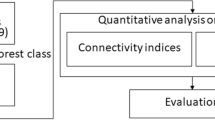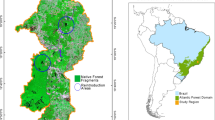Abstract
Context
Maintaining connectivity is critical for fragmented habitat networks to retain native species. The tropical forest in Xishuangbanna, Southwest China, is a biodiversity hotspot for China, but is also vulnerable to deforestation due to rapid expansion of rubber plantations, thus better understanding of connectivity may be crucial to species persistence.
Objectives
To quantify the functional connectivity changes in the forest in Xishuangbanna from 1976 to 2014, and identify the conservation and restoration priorities for effective forest conservation and management.
Methods
Using the graph theory (in Conefor sensinode 2.6), forest connectivity from 1976 to 2014 was quantified using probability of connectivity and number of components indexes. The importance of each forest patch during each period and the potential contribution of low-profit rubber plantation patches in 2014 was quantified and ranked by delta values for PC (dPC) index.
Results
Connectivity of forest in Xishuangbanna has progressively decreased over the last 40 years. The ten forest patches which had the highest dPC value remained almost the same for all five periods between 1976 and 2014, though relative importance varied. The 50 most potentially important low-profit rubber plantation patches were identified and mapped, and provide a target for effective restoration efforts to facilitate efficient use of funding to best improve conservation outcomes.
Conclusions
Targeted and effective interventions for landscape scale conservation and management can be made based on graph theory and connectivity analysis. Restoring low-profit rubber provides a mechanism for reconnecting the forest as an effective conservation tool. Here we show the application of this approach to restore forest and most effectively increase connectivity at minimum economic cost.






Similar content being viewed by others
References
Acevedo MA, Sefair JA, Smith JC, Reichert B, Fletcher RJ, Fuller R (2015) Conservation under uncertainty: optimal network protection strategies for worst-case disturbance events. J Appl Ecol 52:1588–1597
Ahlheim M, Borger T, Fror O (2015) Replacing rubber plantations by rainforest in Southwest China–who would gain and how much? Environ Monit Assess 187:3
Andelman SJ, Fagan WF (2000) Umbrellas and flagships: efficient conservation surrogates or expensive mistakes? Proc Natl Acad Sci USA 97(11):5954–5959
Aratrakorn S, Thunhikorn S, Donald PF (2006) Changes in bird communities following conversion of lowland forest to oil palm and rubber plantations in southern Thailand. Bird Conserv Int 16:71
Baranyi G, Saura S, Podani J, Jordán F (2011) Contribution of habitat patches to network connectivity: redundancy and uniqueness of topological indices. Ecol Indicat 11:1301–1310
Cao M, Hu H, Tang Y, Fu X (2003) Human dimension of tropical forest in Xishuangbanna, SW China. In: Cao M, Woods K, Hu HB, Li LM (eds) Biodiversity management and sustainable development. China Forestry Publishing House, Beijing, pp 151–159
Chen HF, Yi ZF, Schmidt-Vogt D, Ahrends A, Beckschafer P, Kleinn C, Ranjitkar S, Xu J (2016) Pushing the limits: the pattern and dynamics of rubber monoculture expansion in Xishuangbanna, SW China. PLoS ONE 11:e0150062
Cotter M, Häuser I, Harich FK, He P, Sauerborn J, Treydte AC, Martin K, Cadisch G (2017) Biodiversity and ecosystem services—A case study for the assessment of multiple species and functional diversity levels in a cultural landscape. Ecol Indic 75:111–117
Fletcher RJ, Burrell NS, Reichert BE, Vasudev D, Austin JD (2016) Divergent perspectives on landscape connectivity reveal consistent effects from genes to communities. Curr Landsc Ecol Rep 1:67–79
Foltête J-C, Girardet X, Clauzel C (2014) A methodological framework for the use of landscape graphs in land-use planning. Landsc Urban Plan 124:140–150
Fu W, Liu SL, Degloria SD, Dong SK, Beazley R (2010) Characterizing the fragmentation–barrier effect of road networks on landscape connectivity: a case study in Xishuangbanna, Southwest China. Landsc Urban Plan 95:122–129
Gao W, Zhu W (2014) Study of Biodiversity situation and it’s conservation measure in Yunnan Province. Bioprocess 4:35–43
Haddad NM, Brudvig LA, Clobert J, Davies KF, Gonzalez A, Holt RD, Cook WM (2015) Habitat fragmentation and its lasting impact on Earth’s ecosystems. Sci Adv 1(2):e1500052
Hatfield JH, Orme CD, Banks-Leite C (2018) Using functional connectivity to predict potential meta-population sizes in the Brazilian Atlantic Forest. Perspect Ecol Conserv 16(4):215–220
Hu HB, Liu WJ, Cao M (2008) Impact of land-use and land-cover changes on ecosystem services in Menglun, Xishuangbanna, Southwest China. Environ Monit Assess 146:147–156
Huang H, Huang H, Zhang W (2015) How to develop rubber production in Xishuangbanna Dai autonomous prefecture? Asian Agric Res 7:33
Hughes AC (2017) Mapping priorities for conservation in Southeast Asia. Biol Conserv 209:395–405
Jones KR, Plumptre AJ, Watson JE, Possingham HP, Ayebare S, Rwetsiba A, Klein CJ (2016) Testing the effectiveness of surrogate species for conservation planning in the Greater Virunga Landscape, Africa. Landsc Urban Plan 145:1–11
Lawrence A, O’Connor K, Haroutounian V, Swei A (2018) Patterns of diversity along a habitat size gradient in a biodiversity hotspot. Ecosphere 9(4):e02183
Lechner AM, Sprod D, Carter O, Lefroy EC (2016) Characterising landscape connectivity for conservation planning using a dispersal guild approach. Landsc Ecol 32:99–113
Li ZJ (2008) The land-use/cover change and its impact on climate in Xishuangbanna, Southern China. Dissertation, Graduate school of Chinese Academy of Sciences, Beijing
Li HM, Aide TM, Ma YX, Liu WJ, Cao M (2007) Demand for rubber is causing the loss of high diversity rainforest in SW China. Biodivers Conserv 16:1731–1745
Li HM, Ma YX, Liu WJ, Liu WJ (2009) Clearance and fragmentation of tropical rainforest in Xishuangbanna, SW, China. Biodivers Conserv 18:3421–3440
Li HM, Ma YX, Liu WJ, Liu WJ (2012) Soil changes induced by rubber and tea plantation establishment: comparison with tropical rainforest soil in Xishuangbanna, SW China. Environ Manage 50:837–848
Li L, Xue Y, Wu G, Li D, Giraudoux P (2014) Potential habitat corridors and restoration areas for the black-and-white snub-nosed monkey Rhinopithecus bieti in Yunnan, China. Oryx 49:719–726
Liu SL, Deng L, Dong SK, Zhao QH, Yang JJ, Wang C (2014) Landscape connectivity dynamics based on network analysis in the Xishuangbanna Nature Reserve, China. Acta Oecol 55:66–77
Liu SL, Yin YJ, Liu XH, Cheng FY, Yang JJ, Li JR, Dong SK, Zhu A (2017) Ecosystem Services and landscape change associated with plantation expansion in a tropical rainforest region of Southwest China. Ecol Model 353:129–138
Liu WJ, Hu HB, Ma YX, Li HM (2006) Environmental and socioeconomic impacts of increasing Rubber Plantations in Menglun Township, Southwest China. Mountain Res Dev 26:245–253
Mei CC (2015) The spatial-temporal evolution of rubber plantation and the distribution patterns of aboveground biomass carbon stroage in Xishuangbanna. Dissertation, Graduate school of Chinese Academy of Sciences, Beijing
Ministry of Environmental Protection of China (2010) National Biodiversity Strategy and Action Plan in China (2011–2030). http://www.zhb.gov.cn/gkml/hbb/bwj/201009/t20100921_194841.htm. Accessed 31 Jan 2015
Mitchell MGE, Bennett EM, Gonzalez A (2013) Linking landscape connectivity and ecosystem service provision: current knowledge and research gaps. Ecosystems 16:894–908
Mony C, Abadie J, Gil-Tena A, Burel F, Ernoult A (2018) Effects of connectivity on animal-dispersed forest plant communities in agriculture-dominated landscapes. J Veg Sci 29(2):167–178
Myers N, Mittermeier RA, Mittermeier CG, Da Fonseca GA, Kent J (2000) Biodiversity hotspots for conservation priorities. Nature 403(6772):853
Nyhus P, Tilson R (2004) Agroforestry, elephants, and tigers: balancing conservation theory and practice in human-dominated landscapes of Southeast Asia. Agric Ecosyst Environ 104(1):87–97
Phommexay P, Satasook C, Bates P, Pearch M, Bumrungsri S (2011) The impact of rubber plantations on the diversity and activity of understorey insectivorous bats in southern Thailand. Biodivers Conserv 20:1441–1456
Sahraoui Y, Foltête J-C, Clauzel C (2017) A multi-species approach for assessing the impact of land-cover changes on landscape connectivity. Landsc Ecol 32:1819–1835
Saunders DA, Hobbs RJ, Arnold GW (1993) The Kellerberrin project on fragmented landscapes: a review of current information. Biol Conserv 64(3):185–192
Saura S, Pascual-Hortal L (2007) A new habitat availability index to integrate connectivity in landscape conservation planning: comparison with existing indices and application to a case study. Landsc Urban Plan 83:91–103
Saura S, Rubio L (2010) A common currency for the different ways in which patches and links can contribute to habitat availability and connectivity in the landscape. Ecography 33(3):523–537
Shaffer LJ, Khadka KK, Van Den Hoek J, Naithani KJ (2018) Human-Elephant conflict: a review of current management strategies and future directions. Front Ecol Evolut 6:235
Shanthala Devi BS, Murthy MSR, Debnath B, Jha CS (2013) Forest patch connectivity diagnostics and prioritization using graph theory. Ecol Model 251:279–287
Sturgeon JC, Menzies NK, Schillo N (2014) Ecological governance of rubber in Xishuangbanna, China. Conserv Soc 12:376–385
Tan Z-H, Zhang Y-P, Song Q, Liu W-J, Deng X-B, Tang J-W, Deng Y, Zhu W, Yang L-Y, Yu G-R, Sun X, Liang N (2011) Rubber plantations act as water pumps in tropical China. Geophys Res Lett 38:24406
Taylor PD, Fahrig L, Henein K, Merriam G (1993) Connectivity is a vital element of landscape structure. Oikos 68:571–572
Tischendorf L, Fahrig L (2000) How should we measure landscape connectivity. Landsc Ecol 15:633–641
Urban D, Keitt T (2001) Landscape connectivity: a graph theoretic perspective. Ecology 82:1205–1218
Wang L, Young SS, Wang W, Ren G, Xiao W, Long Y, Li J, Zhua J (2016) Conservation priorities of forest ecosystems with evaluations of connectivity and future threats: implications in the Eastern Himalaya of China. Biol Conserv 195:128–135
Xiao HF, Tian YH, Zhou HP, Ai XS, Yang XD, Schaefer DA (2014) Intensive rubber cultivation degrades soil nematode communities in Xishuangbanna, southwest China. Soil Biol Biochem 76:161–169
Xu JC, Grumbine RE, Beckschäfer P (2014) Landscape transformation through the use of ecological and socioeconomic indicators in Xishuangbanna, Southwest China, Mekong Region. Ecol Indic 36:749–756
Yi ZF, Cannon CH, Chen J, Ye CX, Swetnam RD (2013) Developing indicators of economic value and biodiversity loss for rubber plantations in Xishuangbanna, southwest China: a case study from Menglun township. Ecol Indic 36:788–797
Yin DY, Leroux SJ, He FL (2017) Methods and models for identifying thresholds of habitat loss. Ecography 40:131–143
Zhai DL, Xu JC, Dai ZC, Schmidt-Vogt D (2017) Lost in transition: forest transition and natural forest loss in tropical China. Plant Divers 39:149–153
Zhang J (2015) Research on the construction of the Environment-friendly ecological rubber plantation. J Yunnan Agric Univ 9:24–29
Zhang MX, Chang C, Quan RC (2017) Natural forest at landscape scale is most important for bird conservation in rubber plantation. Biol Cons 210:243–252
Zhang Y, Li L, Wu GS, Zhou Y, Qin SP, Wang XM (2016) Analysis of landscape connectivity of the Yunnan snub-nosed monkeys (Rhinopithecus bieti) based on habitat patches. Acta Ecol Sin 36:51–58
Zheng G, Li S, Yang X (2015) Spider diversity in canopies of Xishuangbanna rainforest (China) indicates an alarming juggernaut effect of rubber plantations. For Ecol Manage 338:200–207
Zhu H, Wang H, Li B, Zhou S, Zhang J (2015) Studies on the forest vegetation of Xishuangbanna. Plant Sci J 33:641–726
Acknowledgements
Supported by Chinese National Natural Science Foundation (Grant #: U1602265, Mapping Karst Biodiversity in Yunnan). Supported by the Strategic Priority Research Program of the Chinese Academy of Sciences (Grant No. XDA20050202). Supported by the High-End Foreign Experts Program of Yunnan Province (Grant #: Y9YN021B01, Yunnan Bioacoustic monitoring program). Supported by the CAS 135 program (No. 2017XTBG-T03). Supported by West Light Talent Program of the Chinese Academy of Sciences (Grant No. Y9XB011B01). Supported by the Chinese Academy of Sciences Southeast Asia Biodiversity Research Center fund (Grant #: Y4ZK111B01).
Author information
Authors and Affiliations
Corresponding authors
Additional information
Publisher's Note
Springer Nature remains neutral with regard to jurisdictional claims in published maps and institutional affiliations.
Electronic supplementary material
Below is the link to the electronic supplementary material.
Rights and permissions
About this article
Cite this article
Liu, W., Hughes, A.C., Bai, Y. et al. Using landscape connectivity tools to identify conservation priorities in forested areas and potential restoration priorities in rubber plantation in Xishuangbanna, Southwest China. Landscape Ecol 35, 389–402 (2020). https://doi.org/10.1007/s10980-019-00952-2
Received:
Accepted:
Published:
Issue Date:
DOI: https://doi.org/10.1007/s10980-019-00952-2




